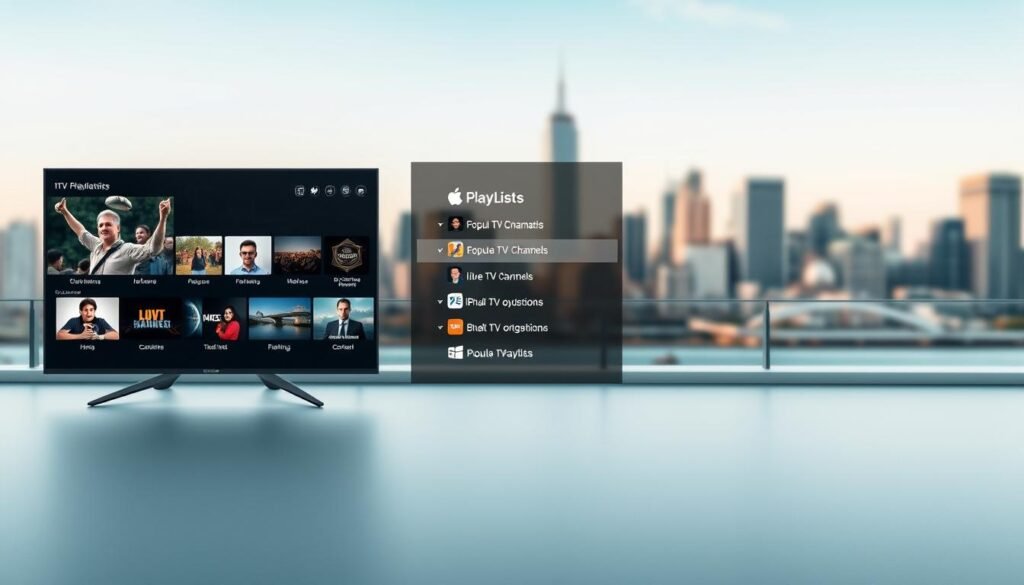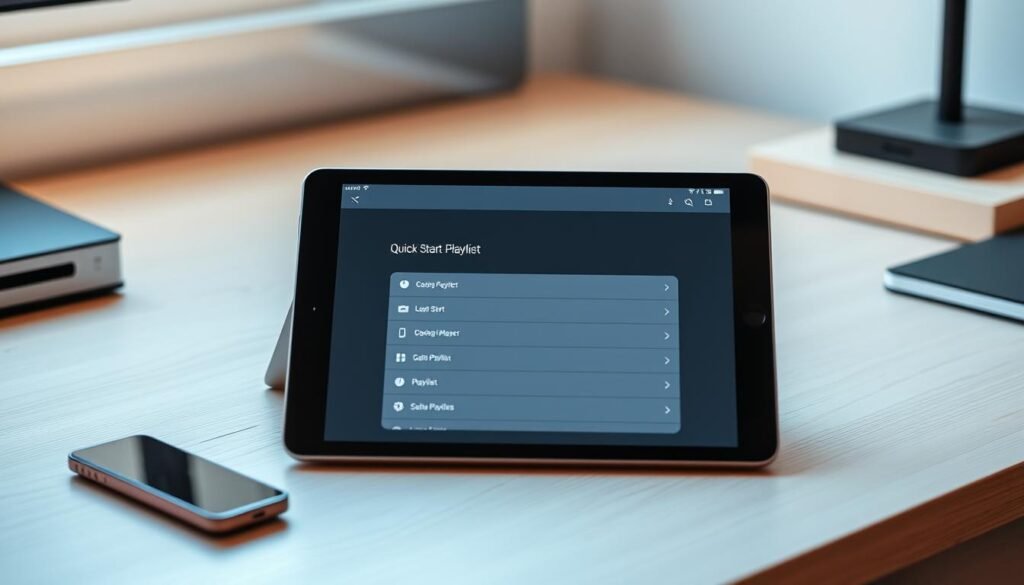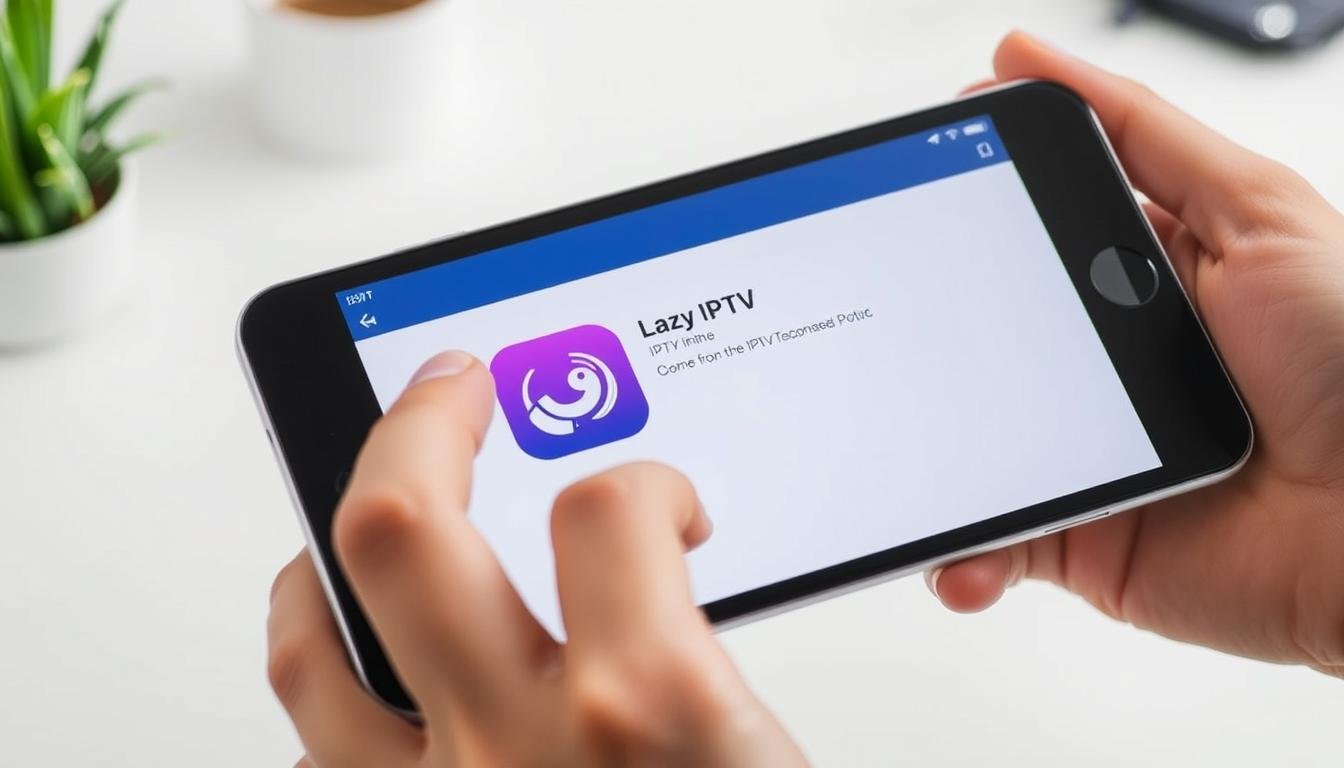Quick setup for Apple devices can make streaming simple and reliable. This introduction outlines what you need, the best app choices, and why proper links and a steady connection matter.
Many reputable apps from the App Store accept M3U/M3U8 links and Xtream credentials. Options like ZanApps, GSE Smart IPTV, IPTV Smarters, IPTVX and iPlayTV offer PiP, AirPlay and iCloud sync across devices such as iPhone, iPad and Apple TV.
Remember: the app is a media tool and does not supply content. You need a lawful playlist or Xtream API details and a stable LTE/5G or broadband link for smooth playback.
This guide will cover selecting features (EPG, favourites, search, multi‑playlist handling), organizing channels by category, and simple troubleshooting for expired links or buffering.
Key Takeaways
- Choose trusted apps with PiP, AirPlay and iCloud sync for the best experience.
- Use lawful M3U/M3U8 URLs or Xtream credentials and a stable internet connection.
- EPG may require a manual URL or an in‑app purchase in some apps.
- Organize channels by category, region and language for easier browsing.
- For Canada, AirPlay to Apple TV and Chromecast casting are common and useful.
- See a step‑by‑step Android guide for a related workflow at Android setup guide.
What you need before you start on iOS and iPadOS
Make sure a valid playlist or Xtream account is ready and that your network can handle live streams. Gather credentials from a reputable provider and confirm the source includes EPG data or a separate EPG URL. Legal services clearly state they do not supply channels and may require refreshed links over time.

Checklist for a smooth setup
- Obtain a lawful M3U/M3U8 URL or Xtream credentials; broken links are often rejected by an iptv player.
- Use stable broadband or a strong LTE/5G signal; HD channels need higher bandwidth for good quality.
- Keep a backup playlist in iCloud Drive or another cloud service for quick re‑import if links change.
- Confirm your device supports PiP and AirPlay and review the app’s support pages for casting limits.
- Note token rotation on websites hosting playlist URLs—expired tokens are a common cause of errors.
Quick start: install an IPTV player and load your playlist
Choose a reputable app with recent updates, then have your playlist or Xtream credentials ready for import.
Get the app: open the App Store, search for a trusted app with solid ratings and recent updates, and tap Install. Popular options include ZanApps, GSE Smart IPTV, IPTV Smarters, IPTVX and iPlayTV.
Add your source: launch the app, tap Add or + and pick either the M3U/M3U8 URL option or Xtream Codes. Enter the server URL, username and password supplied by your provider.

Once imported, the app builds categories and channels. Use the search box to find a channel and mark favourites for fast access. If an EPG is available, add its URL in settings.
- Test AirPlay or Chromecast from the cast button; ensure devices share the same network.
- Rename sources (e.g., “News/CA”) and allow time for logos and guide data to cache.
- Enable Face ID/Touch ID lock for added support and privacy.
| App | Supports M3U/Xtream | Sync/Lock | Notes |
|---|---|---|---|
| ZanApps | Yes | iCloud sync, Face/Touch ID | Labels “Playlists” as “Sources”; strong import tools |
| GSE Smart IPTV | Yes | iCloud optional | Flexible EPG handling |
| IPTV Smarters | Yes (Xtream API) | Device lock available | Good for multiple lists |
| IPTVX / iPlayTV | Yes | Varies by app | Premium interfaces, multiview options |
How to install m3u iptv player on ios/iPhone/ iPad
The same app can feel very different on a phone versus a tablet because of layout and artwork size.
Interface differences: On a phone expect a compact display with bottom tabs and a single column of channels. A tablet often shows multi‑column navigation, larger thumbnails and faster category browsing.
Grant local network permission on first run so the app can find casting targets and fetch guide images without errors. If your playlist is in iCloud Drive, allow Files access for direct import.
Picture‑in‑Picture and sign‑in: Enable PiP in the app and system settings so playback continues in a floating window while you use other apps. Sign in or enable iCloud sync if the app supports it to share favourites across devices.
On a tablet, use split view with your browser or EPG to paste links quickly and manage large lists. If import stalls, quit and relaunch the app; many players re‑index faster on a second attempt.
- Set default aspect ratio and subtitle font in playback settings for a better viewing experience.
- Enable Face ID/Touch ID for app privacy where available.
- Keep the app updated for stability and new features.
Adding IPTV sources: M3U, M3U8, and Xtream Codes
You can import sources using a live web URL, a stored file, or an iCloud Drive item in many apps.
Import from web URL, local file, or iCloud Drive
Use a web URL import for dynamic playlists that update on the provider side. A local file or iCloud Drive import works best for fixed lists you manage yourself.
When to choose Xtream API over standard M3U/M3U8
Choose the Xtream API when you want clear grouping of Live, VoD and Series categories and simpler EPG mapping. Standard M3U/M3U8 formats remain universal and quick for basic channel lists.
Organizing multiple playlists into categories and regions
Rename and colour‑code each source so regions like CA, US or UK are obvious at a glance. Create themed sources—news, sports, kids—to keep daily browsing uncluttered.
- Include tvg-id and logo tags in a playlist for better labelling and EPG matching.
- Refresh metadata if logos or groups appear messy after import.
- If tokens rotate, prefer the Xtream API or plan scheduled URL updates.
| Import method | Best for | Notes |
|---|---|---|
| Web URL | Dynamic playlists | Auto-updates; watch for token expiry |
| Local file / iCloud | Static curated lists | Good for offline edits and backups |
| Xtream API | Multi-category setups | Fetches Live/VoD/Series and often aligns EPG |
Keep a secure note of all URLs and login details. Labeled information speeds recovery if you ever reinstall the app or move devices in Canada.
Choosing the right IPTV player app for Apple devices
Some apps focus on format support and EPG, while others prioritise polished interfaces and sync. Pick what matters most: ease of use, casting, auto‑EPG or multiview. Below are concise notes on popular choices in Canada.
GSE Smart IPTV
GSE Smart IPTV supports M3U, JSON, HLS and RTMP. It includes a built‑in EPG, parental controls and AirPlay/Chromecast options.
The app is free with ads, offers a one‑time ad removal, and has optional subscriptions for extra features.
IPTV Smarters / Smarters Lite
IPTV Smarters works well with Xtream APIs and multiple lists. It has search and day/night modes.
Some users note occasional buffering or A/V sync quirks; premium tiers improve casting and stability.
IPTVX and iPlayTV
IPTVX brings a Netflix‑style UI, multiview and HDR support on compatible screens. Auto‑EPG and iCloud sync simplify setup.
iPlayTV uses a one‑time purchase model with strong multi‑list tools, logo detection and time‑shifted EPG.
Free and freemium picks
Flex IPTV, OttPlayer, Cloud Stream and IPTV Stream Player cover different needs—auto updates, web portals, Chromecast, 4K playback and robust parental controls.
Tip: match app features with your sources and check the developer update cadence and recent reviews before committing.
Core features that improve your viewing experience
Modern streaming apps pack handy features that speed up channel discovery and playback control. These tools make daily tuning faster and reduce time spent scrolling.
Search, favourites, and sorting by most used channels
Use the search box to jump straight to a channel name. Mark favourites and build a short list you open in seconds.
Many apps include a “sort by most used” option. This moves your regular channels to the top for quicker access.
Picture‑in‑Picture, full‑screen, and multi‑view
Enable PiP to keep video visible while you check messages or the guide. Full‑screen hides controls for distraction‑free watching.
Some apps offer multiview on tablets and Apple TV, letting you watch multiple live feeds at once.
Playback quality, multiple audio tracks, and subtitles
Adjust playback quality during congestion to reduce buffering and keep streams stable. Choose alternate audio tracks for multilingual broadcasts.
Turn on subtitles when needed and use parental controls to lock mature channels. Small tweaks like deinterlacing and aspect ratio can improve picture quality for certain series and live feeds.
- Spotlight integration can resume a channel from iOS search.
- Swipe gestures and long‑press actions speed up channel switching.
AirPlay and Chromecast: streaming to the big screen in Canada
Set up well and you can move live TV from hand-held to living-room with minimal fuss. A reliable app, a stable network and a compatible receiver make the difference. Many modern apps offer tvOS and macOS companions that add native support for couch‑friendly navigation.
AirPlay to Apple TV and AirPlay‑enabled devices
Ensure your devices share the same Wi‑Fi. Tap the app’s cast icon and pick your Apple TV or an AirPlay‑enabled TV to mirror the video to a bigger screen. If only audio plays, check whether video casting is a premium feature in that app.
Chromecast casting from supported iOS apps
Pick an app that lists Chromecast support, then tap the cast icon and select your Chromecast device or a TV with Chromecast built‑in. Reboot the receiver if discovery fails; power‑cycling often clears handshake problems.
“For best quality use 5 GHz Wi‑Fi and wired Ethernet on tvOS during big events.”
- Tip: keep your mobile device awake if an app needs it to maintain the stream.
- Check the app’s support notes for regional limits or firmware needs for devices sold in Canada.
- Try the IPTV Player app if you need a solution that lists both AirPlay and Chromecast features.
EPG setup: guide data, time‑shift, and in‑app purchases
Before watching, confirm that guide sources and time settings match your local region.
Auto‑EPG detection works well when a playlist includes tvg‑id or xmltv references. Many apps will populate listings automatically and save setup time.
If auto detection fails, add an XMLTV EPG URL manually in the app’s guide settings and refresh. Ensure the URL is reachable and correctly formatted.
Free vs paid EPG and practical tips
Expect differences: some apps include basic guide features for free, while full guide functions may require a one‑time fee or subscription.
- Set the time‑shift or time‑zone offset so show times match Canadian local time.
- Large EPG files can take several minutes to index; wait before troubleshooting.
- If names mismatch, check that channel IDs in your playlist align with the EPG source.
| Task | When to use | Notes |
|---|---|---|
| Auto‑EPG | Playlist includes tvg‑id/xmltv | Fastest; no manual URL needed |
| Manual XMLTV URL | Auto fails or alternate source desired | Ensure URL format and reachability |
| Alternate EPG source | Provider data unreliable | Pick a legal XMLTV provider for your region |
Save both playlist and guide URLs so updates do not break mapping. If the guide disappears after an update, clear cache and re‑import to restore listings.
Syncing across your Apple ecosystem
Keep your viewing setup consistent by syncing app data across every Apple device you use.
Many apps offer iCloud sync for playlists, favourites and watch history. Enable iCloud in the app’s settings so sources and recent activity appear on devices signed to the same Apple ID.
On Apple TV, install the companion app for a remote‑friendly interface and direct access to your synced lists. This reduces the need to mirror from your phone and gives a native living‑room experience.
macOS editions let you edit sources on a larger screen and push changes back to mobile devices. If sync stalls, sign out of your Apple ID and sign back in, then confirm iCloud Drive is enabled for the app.
Quick tips for reliable cross‑device data
- Wait for the sync indicator after adding a new source before switching devices; this avoids duplicates.
- Use separate Apple IDs or app profiles for family members to keep favourites and history private.
- If an app lacks iCloud support, use its export/import feature to move sources between devices.
- Check update notes regularly; developers often improve cross‑device performance in new releases.
For a companion option that lists cloud features and remote support, see the IPTV Streamer Pro app.
Troubleshooting streams, buffering, and playlist issues
Buffering and guide mismatches are common, but most issues clear up with a few simple checks.
Fixing expired links, outages, and guide mismatches
If channels stop working suddenly, confirm your playlist URL hasn’t expired and ask your provider for a fresh link or an Xtream API login. Test a few unrelated channels and a second device to check for outages.
For EPG mismatches, refresh the guide URL and verify channel IDs match the guide source. A remap often restores proper listings.
Improving playback and network checks
- Run a built‑in speed test or use a reputable site to confirm bandwidth for your desired quality.
- Change Wi‑Fi channels, move closer to the router, or switch to 5 GHz to reduce interference.
- Reboot modem/router and, where possible, use Ethernet on Apple TV for steady streams.
When to swap protocols or apps
If one app struggles with a source, try another app that supports the same formats. Different playback engines and updated versions often fix import failures, favourites not saving, and buffering.
For community examples of stuttering, see the stuttering streams thread for practical tips and support.
Privacy, safety, and copyright considerations in Canada
Privacy and copyright matters are as important as stream quality when using third‑party sources in Canada.
Players are media tools only — they do not supply or host streams. Canadian users must ensure any content they add complies with local copyright law. If a source looks “all‑inclusive” or free without clear terms, treat it with caution.
Review each app’s privacy label before granting permissions. Some developers collect location, device identifiers, and usage data; these categories may vary by app. Read privacy policies and EULAs to understand iCloud sync, analytics, and data retention.
Use built‑in parental controls, PINs, or Face ID/Touch ID to restrict mature sections. Avoid sharing playlist URLs publicly; leaked links can expose account details or lead to abuse. For cross‑platform notes and related setup advice, see the Android setup guide.
| Risk | Action | Note |
|---|---|---|
| Copyright exposure | Use verified, paid subscriptions | Legal services list terms clearly |
| Data tracking | Check app privacy labels | Permissions and tracking may vary |
| Shared URLs | Keep playlists private | Do not post links publicly |
If an app requests unrelated permissions, or charging for EPG and features is unclear, reconsider installation. Stick to App Store apps for better vetting and regular updates. Replace questionable streams immediately to protect your device and personal information.
Conclusion
,
A short roundup makes it easy to pick the right app, manage playlists, and improve everyday playback.
Choose trusted apps with recent updates and clear privacy notes. Use lawful sources for all content and keep credentials private.
Organize channels into named lists and add an EPG for accurate show times. Enable iCloud sync where available so favourites and settings follow your devices.
If streams buffer, test your network, tweak playback quality, or try a different app or format. Active developers and frequent updates often mean better long‑term support.
Final note: with the right app, tidy playlists and a reliable EPG, watching movies, series and live shows becomes simple and consistent across screens in Canada.



